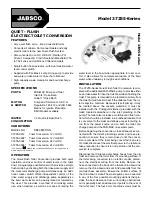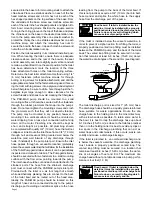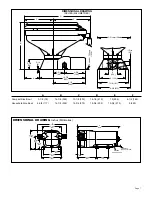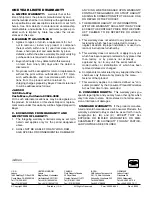
3
5
6
4
2
1
PARTS LIST
Qty.
Part
Key
Description
Req.
Number
1
Port Kit (1 pair)
1
30653-1004
2
Body Kit
1
30608-1001
3
Valve Cage / Valve Assembly
1
30613-1000
4
Diaphragm Kit
1
30617-1000
5
Diaphragm Housing &
Retainer Cap Kit
1
30682-1000
6
Motor Kit 12 Vdc
1
18753-0463
Motor Kit 12 Vdc EMC
1
18753-0577
Motor Kit 24 Vdc
1
18753-0464
Motor Kit 24 Vdc EMC
1
18753-0578
Motor/Pump Assy 12 Vdc
1
30631-1012
Motor/Pump Assy 12 Vdc EMC
1
30631-1092
Motor/Pump Assy 24 Vdc
1
30631-1024
Motor/Pump Assy 24 Vdc EMC
1
30631-1094
EXPLODED VIEW
Page 6
PAR-MAX SERVICE INSTRUCTIONS
The PAR-MAX rinse water supply pump needs no peri-
odic maintenance for proper performance. The only time
service work should need to be performed on the pump
is if it should begin to leak water, suddenly delivers less
water than normal or should stop pumping altogether.
Should the pump begin to leak water, it will be necessary
to replace the diaphragm. If the pump delivers a reduced
rate of flow from normal or stops pumping altogether, it
will be necessary to either remove debris from the
pump’s flapper valves or replace the valve cage assembly.
Notice: Before performing any service, turn off the
electrical power to the toilet and rinse water pump. Take
precaution to ensure it is not turned on until service is
complete. Close the inlet fitting seacock.
It is generally easiest to remove the pump from its
installed position so that the service can be performed
on a work bench. To do this, disconnect the electrical
wires from the motor wire leads. Push the port retainer
clips back toward the pump motor and pull the port fit-
tings from the port sockets. Unscrew the four pump
mounting fasteners and remove the pump to a location
where it can be disassembled without losing any of the
pump components.
Loosen the four 5/16" hex (slotted) machine screws in
the pump body and remove the body from the motor and
wobble plate housing (use care to not drop and lose the
port retainer clips and body retaining screws and washers).
The valve cage will now be exposed which can be easily
lifted off the diaphragm. Inspect the four outer inlet valves
and central discharge valve to ensure they seat smooth-
ly against the valve cage. Lift the outer edges of each
valve to make certain there is no debris lodged under
any valve. If there is debris lodged under any of the
valves, it will cause a diminished flow rate or loss of flow
entirely. If the valves do not seat smoothly against the
valve cage, the valve cage assembly should be replaced.
If the pump has been leaking, the diaphragm must be
replaced. Remove the four phillips head diaphragm
retainer screws and mushroom shaped diaphragm
retainer caps. Remove the diaphragm and diaphragm
housing from the motor and wobble plate housing.
Inspect the wobble plate bearing to make certain it is not
corroded and still rotates smoothly.
With the new diaphragm positioned in the diaphragm
housing (ensure the raised sealing beads face outward
away from the motor) hold it against the wobble plate
with the four retaining cap holes aligned with the wobble
plate sockets. Push each diaphragm retainer cap
through the diaphragm and into the socket of the wobble
plate. Secure each retaining cap to the wobble plate with
a 1" phillips head retainer screw. Place the motor on its
rear end bell and position the valve cage against the
diaphragm ensuring each cavities seal groove is seated
on its sealing bead molded into the diaphragm. Ensure
the O-ring seal that separates the pumps intake chamber
from the discharge chamber is properly seated in the ID
of the raised lip around the central discharge valve. While
holding the port retainer clips in their slide grooves in the
pump body, position the body on the diaphragm and
inside the wobble plate housing. Secure the pump body
to the wobble plate housing with the four 2-1/4" machine
screws and flat washers.
Reinstall the pump to its mounting surface with four fas-
teners through the rubber grommets. Ensure the sealing
O-ring is properly positioned on each port fitting and,
with the retaining clips slid back, push each port fitting
into its respective socket. Slide each port retainer clip for-
ward until it snaps securely into its seated position.
Reconnect the orange motor lead to the positive supply
wire and the black motor lead to the negative wire.
Ensure the inlet seacock is open before restoring power
to and operating the toilet.

























